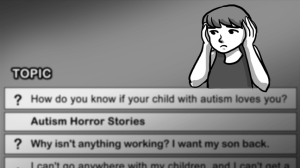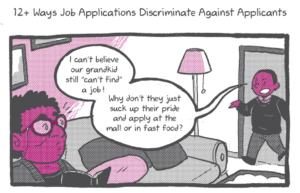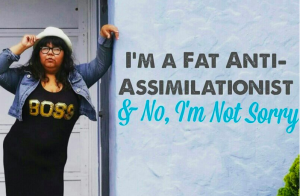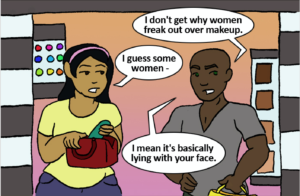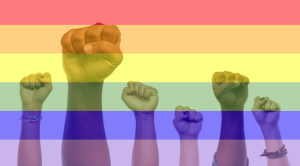
A young kid whispers into the ear of an adult who is smiling.
One day, when I was about twelve, my younger cousin Sasha and I were dancing in our grandmother’s living room as my mom and a few other adults chatted in the kitchen a few feet away.
At one point, Rod Stewart’s old song “Da Ya Think I’m Sexy?” came on the radio. Sasha jumped into the middle of the kitchen, put her hands on her hips, thrust out her butt, and sang along.
My mother was horrified, and she angrily yelped, “Sasha, children cannot be sexy!”
Sasha looked stricken. I was mortified, and my mom refused to talk about what had happened any further.
But the message was clear: The music we were enjoying was inappropriate.
There was something wrong with what we were doing, and anything to do with sex was definitely off-limits with our folks.
And while I’m sure my mom was acting both on her first instinct, and in response to what she saw as an onslaught of sexual messages bombarding her kids, there might have been a more effective way to address the situation.
But like my mom, a lot of parents are frustrated by what they perceive to be the hypersexualization of children and teens – yet they find themselves at a loss about how to address it.
And addressing it is complicated. I mean, how do you help your children develop healthy sexuality while still challenging the damaging messages about sex and their relationship to it that so many are hit with at every turn? How would you address the sexual way your child is dancing without making her feel ashamed?
The answers aren’t always easy. But luckily, there are a number of things you can do to help send a positive message about sexuality to your kids in the face of so many negative ones.
Here are four.
1. Understand the Difference Between Being Sexualized and Expressing Healthy Sexuality
Despite what a lot of people think, it’s possible for children to express sexuality in a healthy way.
This can confuse folks who assume that any of expression of sexuality by children or teens is automatically problematic. But it’s not.
For example, we often assume that girls who wear clothes that show some skin are just doing so because they feel social or media pressure to do so. But using this as the default assumption discounts the fact that may simply like fashion, or are actually comfortable attracting sexual attention from their peers.
Or we may assume that a girl who is sexually active with her high school boyfriend is just doing so to please him or to live up to some expectation of what being sexy means. But adopting this view means that we discount the fact that a lot of girls in this situation are making fully informed positive choices for themselves.
Really, as long as it is not coerced, exploitative, or harmful, sexual expression can be a normal part of development and part of the road to adulthood.
But sadly, healthy sexual expression isn’t what a lot of youth experience – since sexuality is often forced upon children, rather than being self-initiated by them in a developmentally appropriate way.
This element of force – applied physically, psychologically, and through the inescapable onslaught of media messages – is a key component of sexualization of children. And it’s one that can have some pretty bleak consequences.
For example, a task force report from the American Psychological Association found that “[s]exualization has negative effects in a variety of domains, including cognitive functioning, physical and mental health, sexuality, and attitudes and beliefs.”
So determining the circumstances around a child’s sexual expression and figuring out if they’re victims of sexualization is key.
What Parents Can Do
Figuring out what is driving a child’s sexuality can be pretty tricky. Parents often don’t want to ask uncomfortable questions, children may be embarrassed or private, and if abuse is an issue, then the whole situation can become that much more complicated.
Parents shouldn’t automatically assume that a child who expresses interest in sexuality is being exploited, but one of the best ways to determine this is by having an honest conversation with your child.
If you need help with how a conversation about that might look, check out “4 Easy Ways to Incorporate More Sex Positivity into Your Parenting.”
You can also ask some questions to help you gauge the situation.
For example: Is the child exploring their sexuality alone or with a similarly aged peer? Are they simply seeking knowledge? Are the choices they are making about sex free and independent? Are they age appropriate?
If you answer yes, then this very well might be a normal part of their sexual development.
But if you suspect that a child is being forced into sexuality by someone else, or is trying to enact a vision of sexuality that mimics harmful media or porn representations of sex, then they might be sexualized or at least negatively affected by the sexualization around them.
2. Call Out Media Messages That Sexualize Children
Have you ever felt uncomfortable walking by an ad for Bratz Dolls? Or had a sense of unease about a clothing brand using a pouting ten-year-old model dressed like an adult to sell its fare?
If so, that is likely a response to witnessing the sexualization of children.
And what you’re witnessing appears to be on the rise.
Indeed, those were the findings of a study published in the journal Sex Roles, which explored the increase in the number of sexualizing characteristics (low cut shirts and high-heeled shoes, for example) paired with childlike characteristics (say polka-dot prints, Mary-Jane style shoes, pigtails, and lollipop slurping) that has occurred across time in a range of teen magazines.
What else is on the rise is a marketing term called age compression. This refers to the “adultification” of young girls and the “youthification” of adult women, and it is used to sell everything from toys, to snacks, clothing, music, and movies.
Though anyone can be a victim of sexualization, many studies have found that girls and women are far more likely to be sexualized than are boys and men, so addressing girls’ unique experiences of media representation is key.
As Lyn Mikel Brown, a professor at Colby College, and a co-founder of the SPARK Movement, explains:
“Girls exposed to lots of sexualized imagery are more likely to self-objectify or judge themselves by their appearance. So it’s important to point out all the things you love about her and remind her of all the things she can do. Seek out examples of girls and women who are strong, smart, and accomplished. Starting early is important for her and for all of us, because girls who self-objectify are more likely to justify a sexist system and less likely to work to change that system.”
But children of all genders need to understand the effects of sexualization. So don’t limit your conversations to girls.
Heightening awareness about this issue universally is the first step to challenging and dismantling its significant power.
What Parents Can Do
Go for those teachable moments! Point out that the model on a billboard may not be much older than the child you are passing it by with. Explain that the tween show your kids love likely stars thirty-year-olds playing high schoolers.
These simple acts can let your kids know that just because those images are out there, that doesn’t mean this is what’s expected of them – and that such images don’t reflect most people’s lived reality.
It’s also wise to highlight the fact that some people maybe multiply harmed by sexualization. For example, girls of color, disabled youth, and LGBTQIA+ youth can also face eroticization and exotification at the same time that they’re being sexualized.
We also need to talk about the ways that systems like racism, ableism, and heteronormativity make these marginalized youth vulnerable – and give them the tools to recognize when they’re being hurt by sexualization.
While you are at it, advocate for school programs that address media literacy, which is the skill that helps us watch our favorite shows without falling for all the ways they can make us feel bad about our lives, and the sexualization of children.
A good resource is The Representation Project, a movement which has produced films and educational resources that tackle the mainstream media depictions of sexuality, femininity, and masculinity.
3. Call Out Sexist School Dress Codes and Policies That Contribute to the Sexualization of Children
You know what else contributes to the sexualization of kids? School dress codes. Funny, right, since isn’t that often what they purport to be fighting?
Yet, as many people have pointed out, most school dress codes only focus on girls’ clothes, with a particular eye to covering up those girls’ bodies which appear bigger, curvier, or more physically developed than those of their peers. (For example, at one New York City high school, in one two-week period in 2014, 200 students were cited for dress code violations. Of those, 90% were girls!).
But really, what message do we send to a girl when we tell her that her body must be hidden from view so as not to temp or distract others?
Clearly, it’s that she is a sex object. And when you tell someone that they’re a sex object, you are in no uncertain terms sexualizing them.
Here’s the thing: School dress codes turn the outfits girls wear into a sexual battleground.
They tell girls that their bodies are, above all, sexual in nature, and that this is such a bad thing that simply viewing it is harmful. And they reinforce the idea that adults are expected to look at teens and children as sexual entities – and that it’s the job of the youth in question to prevent this.
What Parents Can Do
Ask to read your school’s dress code policy. It’s likely that an update is in order.
Also, if you decide to challenge the code, you might be on stronger footing if you look for ways that it’s applied unfairly and address those. For example, a school can’t ban one student’s “Black Lives Matter” t-shirt while allowing another’s “Make America Great Again” one.
It’s also wise to come armed to any meeting about dress codes with knowledge.
You should know that there are plenty of excuses made for dress codes – like the idea that they “level the playing field,” prevent sexualization, and decrease violence.
And you should also know that these are often based on assumptions or spurious links to studies that are at best inconclusive. In the real world, dress codes have been found to be seriously damaging, as countless students across America can attest.
4. Avoid Contributing to the Sexualization of Your Own Children
Since we live in a world that’s so accustomed to sexualizing children, it can be really easy for parents to inadvertently contribute to this problem.
One of the most common ways is by stressing the importance of appearance, particularly for girls, above all else.
This can start early – just think about baby beauty pageants! And it doesn’t stop there.
Indeed, we live in a world where kids can get breast augmentations as a birthday presents from their folks, and where the American Society for Aesthetic Plastic Surgery reports that last year saw an 80% increase in cosmetic genital surgery among teenage girls.
And while plastic surgery can, of course, be medically necessary, the fact that parents will agree to finance, or even encourage, surgery that is, for the most part, simply designed to affect the appearance of a girl’s sexual anatomy is telling.
What Parents Can Do
Help your children develop their sense of self without focusing on their appearance.
Compliment their accomplishments, rather than their looks. Don’t say things like, “You’d be a lot more attractive if you lost ten pounds and wore some make up.”
Avoid forcing children to conform to into strict gender roles in dress and action.
And above all, remind your kids that their sexuality is their own, not something you control or are invested in.
Rather, give them the message that sexuality is theirs to explore in a safe, mutually agreed on, non-coercive – and yes, developmentally appropriate – manner.
***
Figuring out the line between healthy sexual expression and the sexualization of children sure isn’t easy.
Kids are new to this stuff, and even as adults, many of us personally struggle with living in a hypersexualized world.
But the more we understand what sexualization looks like and how deeply harmful it can be, the better able are we to help our kids through it.
Remember, it’s perfectly normal for a child or teen to want to express their sexuality, but parents should encourage their children to do so on their own terms and not in an attempt to live up to some media idea of what it means to be “sexy.”
Navigating sexuality as a young person shouldn’t be a complicated minefield with the potential for bombs at every turn.
But that’s the experience a lot of kids have – and so having parents around to help defuse some of the more dangerous moments can be a lifesaver for children of all ages, and at all stages of sexual development and exploration.
[do_widget id=’text-101′]
Ellen Friedrichs is a Contributing Writer for Everyday Feminism. She’s a health educator, sometimes writer, and mom. She has worked at Manhattan’s Museum of Sex, developed sex education curricula in Mumbai, India, and run HIV prevention programs for at-risk teens in the South Bronx. Currently, Ellen runs a middle and high school health education program and teaches human sexuality at Brooklyn College. More of Ellen’s writing can be found here. Follow her on Twitter @ellenkatef.
Search our 3000+ articles!
Read our articles about:
Our online racial justice training
Used by hundreds of universities, non-profits, and businesses.
Click to learn more





